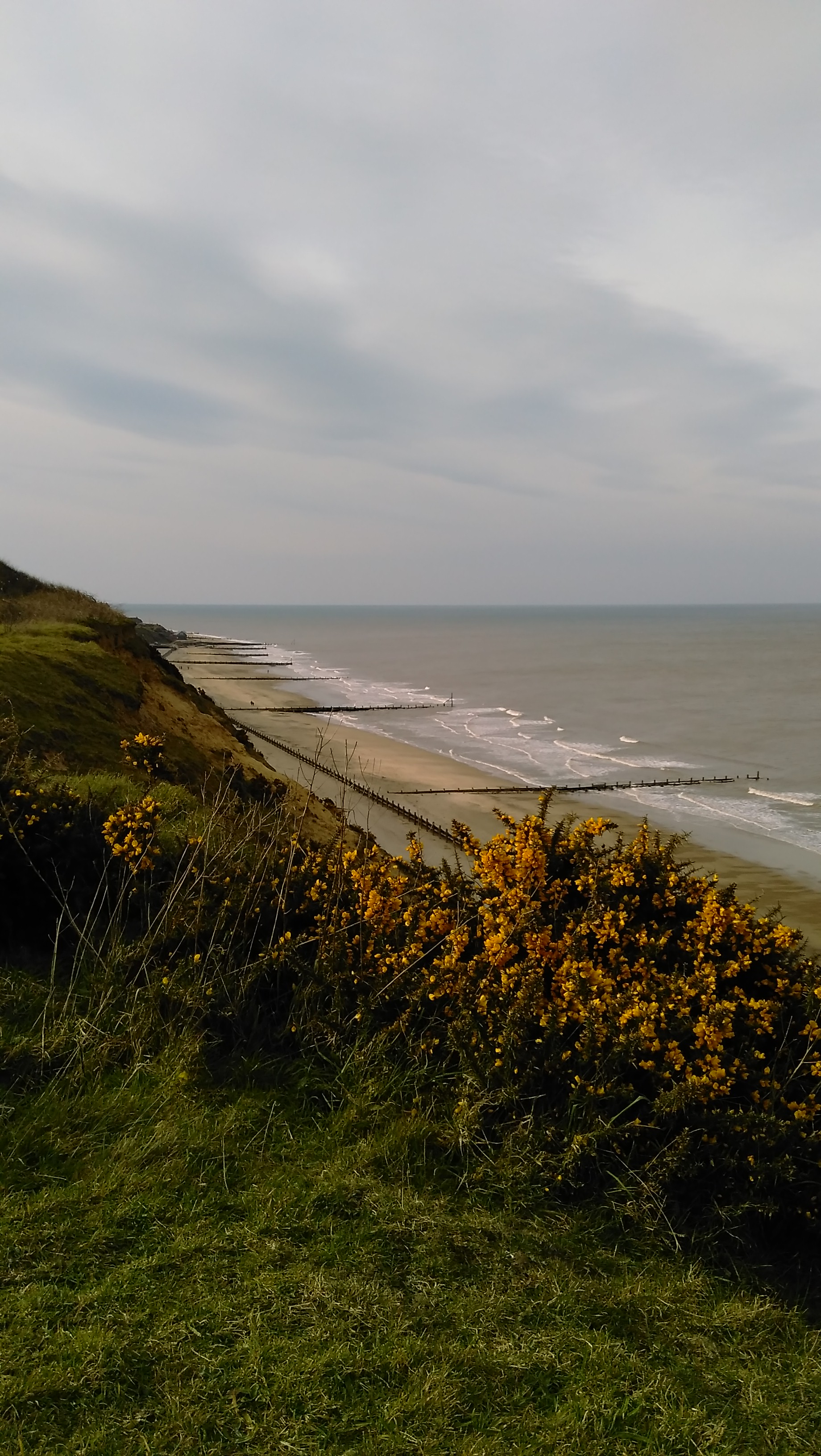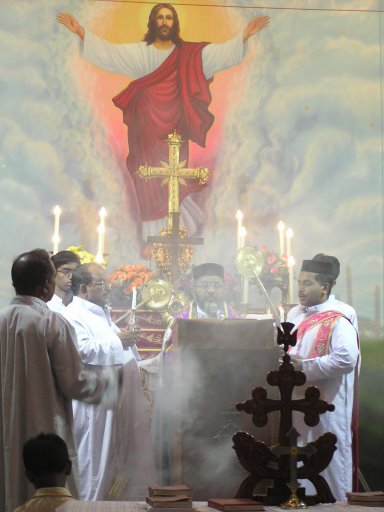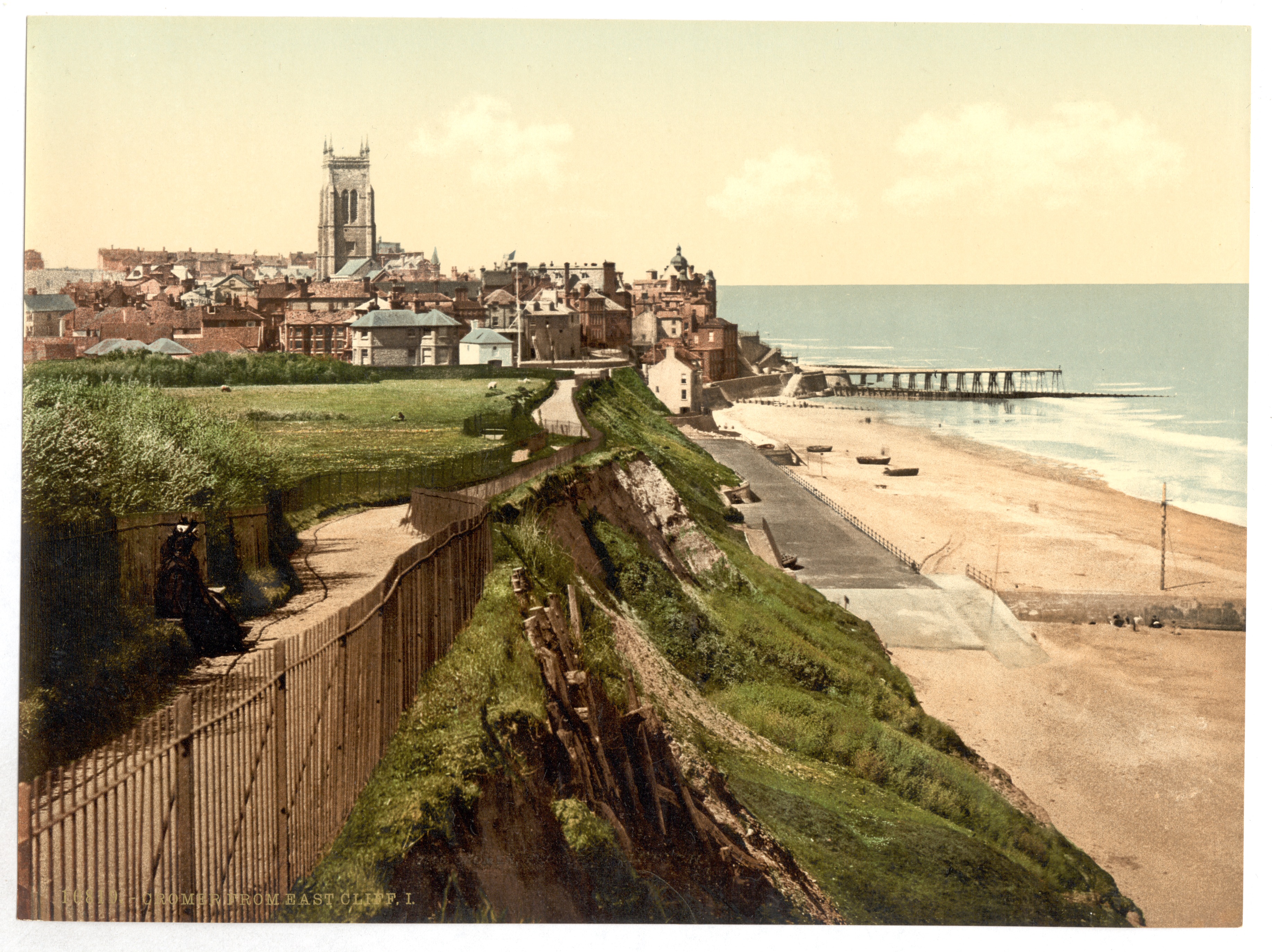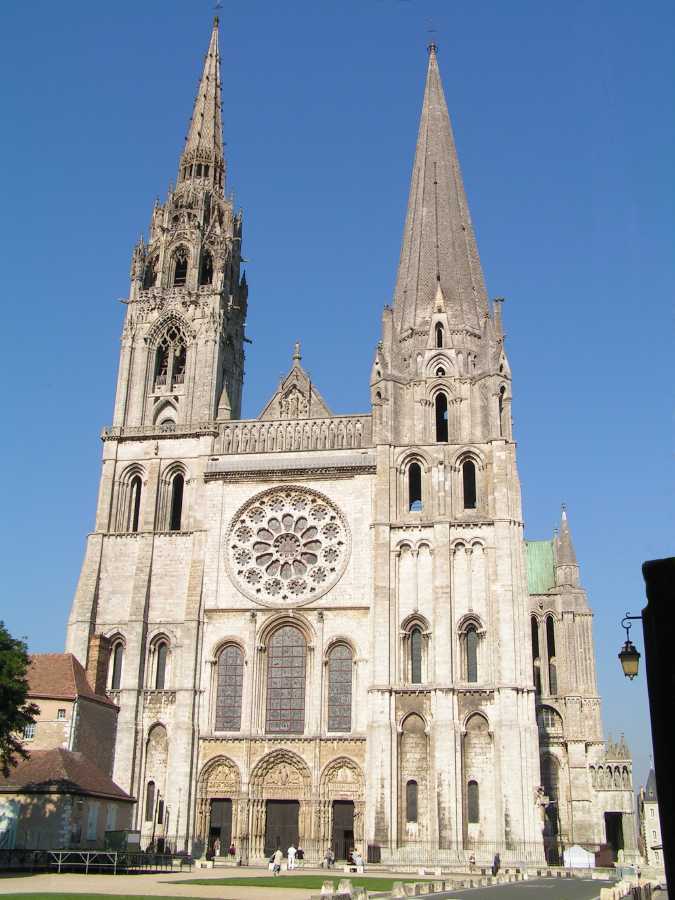|
St Nicholas Church, North Walsham
St Nicholas Church is a parish church in the Church of England in the centre of the Norfolk town of North Walsham. The building is a well known landmark, notable for its collapsed tower. History The present church was commenced in about 1330, although the Saxon church was partially enlarged and altered in around 1275, as a temporary measure to meet the needs of a rapidly expanding town. Work was interrupted by the ' Black Death' plague in 1348 and again in 1361. These fatal epidemics resulted in a lack of skilled craftsmen, a fact which necessitated the austere simple tracery in most of the windows. There was another delay at the time of the Peasants' Revolt in 1381, following the Battle of North Walsham, when a large group of rebellious local peasants was confronted and defeated by the heavily armed forces led by the warlike bishop of Norwich, Henry le Despenser. The completed church was consecrated by le Despenser by the end of the fourteenth century. The church was dedica ... [...More Info...] [...Related Items...] OR: [Wikipedia] [Google] [Baidu] |
North Walsham
North Walsham is a market town and civil parish in Norfolk, England, within the North Norfolk district. Demography The civil parish has an area of and in the 2011 census had a population of 12,634. For the purposes of local government, the parish falls within the district of North Norfolk. Transport The town is south of Cromer, and the same distance north of Wroxham. The county town and city of Norwich is south. The town is served by North Walsham railway station, on the Bittern Line between Norwich, Cromer and Sheringham. The main road through the town is the A149. The town is also located on the B1145, a route that runs between King's Lynn and Mundesley. The town is on the North Walsham & Dilham Canal (privately owned by the North Walsham Canal Company). The canal ran from Antingham Mill, largely following the course of the River Ant, to a point below Honing. A short branch canal leaves the main navigation near Honing and terminates at the village of Dilham. Hi ... [...More Info...] [...Related Items...] OR: [Wikipedia] [Google] [Baidu] |
Bacton, Norfolk
Bacton is a village and civil parish in Norfolk, England. It is on the Norfolk coast, some south-east of Cromer, north-west of Great Yarmouth and north of Norwich. Besides the village of Bacton, the parish includes the nearby settlements of Bacton Green, Broomholm, Keswick and Pollard Street. It also includes Edingthorpe, which was added to Bacton civil parish under the County of Norfolk Review Order, 1935. The seaside village, whose name is derived from 'Bacca's farm/settlement', is located on the North Norfolk coast between Mundesley (a blue flag beach) and Walcott, Norfolk. Bacton is known for its very quiet sandy beaches offering miles of walking along the beach and cliffs. The England Coast Path passes through the village and also the Paston Way long-distance footpath linking Cromer and North Walsham. In the east of the parish can be found the ruined Cluniac Bromholm Priory. The civil parish has an area of and in the 2001 census had a population of 1,130 in 474 house ... [...More Info...] [...Related Items...] OR: [Wikipedia] [Google] [Baidu] |
Paston Way
The Paston Way is a Trail, footpath. It is entirely within the England, English county of Norfolk in the United Kingdom. The footpath is twenty miles in length, the Portal (architecture), portals to the Trail, path are Cromer at its northwestern end and North Walsham at it southeastern end. The Designation The Paston way takes its name from the Paston Letters, Paston Family who during the Medieval and Tudor period, Tudor periods were the dominant and wealthy landowners in which much of the trail passes. The Sir Robert Paston, 1st Earl of Yarmouth, Paston Family in turn had taken their name after the north eastern coastal village of Paston, Norfolk, Paston. Their origins were from Wulston, one of William the Conqueror’s men who arrived with him in 1066. Description of the Route Section 1 Starting at the southeastern end, the path begins at the Parish Church of St Nicholas Church, North Walsham, St Nicholas in the town of North Walsham. This is also the path's conjunction wi ... [...More Info...] [...Related Items...] OR: [Wikipedia] [Google] [Baidu] |
Belfry (architecture)
The belfry is a structure enclosing bells for ringing as part of a building, usually as part of a bell tower or steeple. It can also refer to the entire tower or building, particularly in continental Europe for such a tower attached to a city hall or other civic building. A belfry encloses the bell chamber, the room in which the bells are housed; its walls are pierced by openings which allow the sound to escape. The openings may be left uncovered but are commonly filled with louvers to prevent rain and snow from entering and damaging the bells. There may be a separate room below the bell chamber to house the ringers. Etymology The word ''belfry'' comes from the Old North French or , meaning 'movable wooden siege tower'. The Old French word itself is derived from Middle High German , 'protecting shelter' (cf. the cognate '' bergfried''), combining the Proto-Germanic , 'to protect', or , 'mountain, high place', with , 'peace; personal security', to create , lit. 'high pl ... [...More Info...] [...Related Items...] OR: [Wikipedia] [Google] [Baidu] |
Ascensiontide
The Solemnity of the Ascension of Jesus Christ, also called Ascension Day, Ascension Thursday, or sometimes Holy Thursday, commemorates the Christian belief of the bodily Ascension of Jesus into heaven. It is one of the ecumenical (i.e., shared by multiple denominations) feasts of Christian churches, ranking with the feasts of the Passion and Pentecost. Following the account of that the risen Jesus appeared for 40 days prior to his Ascension, Ascension Day is traditionally celebrated on a Thursday, the fortieth day of Easter; although some Christian denominations have moved the observance to the following Sunday. The day of observance varies by ecclesiastical province in many Christian denominations, as with Methodists and Catholics, for example. History The observance of this feast is of great antiquity. Eusebius seems to hint at the celebration of it in the 4th century. At the beginning of the 5th century, Augustine of Hippo says that it is of Apostolic origin, and he speak ... [...More Info...] [...Related Items...] OR: [Wikipedia] [Google] [Baidu] |
Sexton (office)
A sexton is an officer of a church, congregation, or synagogue charged with the maintenance of its buildings and/or the surrounding graveyard. In smaller places of worship, this office is often combined with that of verger. In larger buildings, such as cathedrals, a team of sextons may be employed. Historically in North America and the United Kingdom the "sexton" was sometimes a minor municipal official responsible for overseeing the town graveyard. In the United Kingdom the position still exists today, related to management of the community's graveyard, and the sexton is usually employed by the town/parish or community council. Origin of the name The words "sexton" and "sacristan" both derive from the Medieval Latin word ''sacristanus'' meaning "custodian of sacred objects". "Sexton" represents the popular development of the word via the Old French "Segrestein". Duties Among the traditional duties of the sexton in small parishes was the digging of graves—the gravedigge ... [...More Info...] [...Related Items...] OR: [Wikipedia] [Google] [Baidu] |
Cromer
Cromer ( ) is a coastal town and civil parish on the north coast of the English county of Norfolk. It is north of Norwich, north-northeast of London and east of Sheringham on the North Sea coastline. The local government authorities are North Norfolk District Council, whose headquarters is on Holt Road in the town, and Norfolk County Council, based in Norwich. The civil parish has an area of and at the 2011 census had a population of 7,683. The town is notable as a traditional tourist resort and for the Cromer crab, which forms the major source of income for local fishermen. The motto ''Gem of the Norfolk Coast'' is highlighted on the town's road signs. History The town has given its name to the '' Cromerian Stage'' or ''Cromerian Complex'', also called the ''Cromerian'', a stage in the Pleistocene glacial history of north-western Europe. Cromer is not mentioned in the ''Domesday Book'' of 1086. The place-name 'Cromer' is first found in a will of 1262 and could mea ... [...More Info...] [...Related Items...] OR: [Wikipedia] [Google] [Baidu] |
Spire
A spire is a tall, slender, pointed structure on top of a roof of a building or tower, especially at the summit of church steeples. A spire may have a square, circular, or polygonal plan, with a roughly conical or pyramidal shape. Spires are typically made of stonework or brickwork, or else of timber structures with metal cladding, ceramic tiling, roof shingles, or slates on the exterior. Since towers supporting spires are usually square, square-plan spires emerge directly from the tower's walls, but octagonal spires are either built for a pyramidal transition section called a ''broach'' at the spire's base, or else freed spaces around the tower's summit for decorative elements like pinnacles. The former solution is known as a ''broach spire''. Small or short spires are known as ''spikes'', ''spirelets'', or ''flèches''. Etymology This sense of the word spire is attested in English since the 1590s, ''spir'' having been used in Middle Low German since the 14th century, a fo ... [...More Info...] [...Related Items...] OR: [Wikipedia] [Google] [Baidu] |
Parapet
A parapet is a barrier that is an extension of the wall at the edge of a roof, terrace, balcony, walkway or other structure. The word comes ultimately from the Italian ''parapetto'' (''parare'' 'to cover/defend' and ''petto'' 'chest/breast'). Where extending above a roof, a parapet may simply be the portion of an exterior wall that continues above the edge line of the roof surface, or may be a continuation of a vertical feature beneath the roof such as a fire wall or party wall. Parapets were originally used to defend buildings from military attack, but today they are primarily used as guard rails, to conceal rooftop equipment, reduce wind loads on the roof, and to prevent the spread of fires. In the Bible the Hebrews are obligated to build a parapet on the roof of their houses to prevent people falling (Deuteronomy 22:8). Parapet types Parapets may be plain, embattled, perforated or panelled, which are not mutually exclusive terms. *Plain parapets are upward extensio ... [...More Info...] [...Related Items...] OR: [Wikipedia] [Google] [Baidu] |
Steeple
In architecture, a steeple is a tall tower on a building, topped by a spire and often incorporating a belfry and other components. Steeples are very common on Christian churches and cathedrals and the use of the term generally connotes a religious structure. They might be stand-alone structures, or incorporated into the entrance or center of the building. Architecture Towers were not a part of Christian churches until about AD 600, when they were adapted from military watchtowers. At first they were fairly modest and entirely separate structures from churches. Over time, they were incorporated into the church building and capped with ever-more-elaborate roofs until the steeple resulted. Towers are a common element of religious architecture worldwide and are generally viewed as attempts to reach skyward toward heavens and the divine. Some wooden steeples are built with large wooden structural members arranged like tent poles and braced diagonally inside both with wood and ste ... [...More Info...] [...Related Items...] OR: [Wikipedia] [Google] [Baidu] |
Tower
A tower is a tall structure, taller than it is wide, often by a significant factor. Towers are distinguished from masts by their lack of guy-wires and are therefore, along with tall buildings, self-supporting structures. Towers are specifically distinguished from buildings in that they are built not to be habitable but to serve other functions using the height of the tower. For example, the height of a clock tower improves the visibility of the clock, and the height of a tower in a fortified building such as a castle increases the visibility of the surroundings for defensive purposes. Towers may also be built for observation, leisure, or telecommunication purposes. A tower can stand alone or be supported by adjacent buildings, or it may be a feature on top of a larger structure or building. Etymology Old English ''torr'' is from Latin ''turris'' via Old French ''tor''. The Latin term together with Greek τύρσις was loaned from a pre-Indo-European Mediterranean languag ... [...More Info...] [...Related Items...] OR: [Wikipedia] [Google] [Baidu] |
Sir William Paston, 1st Baronet
Sir William Paston, 1st Baronet, (1528–1610) was an English benefactor, and the father of Robert Paston, 1st Earl of Yarmouth. Paston was educated at Gonville Hall, Cambridge, in 1546. In 1554 he inherited the family estates. He was Sheriff of Norfolk and Suffolk in 1565 and knighted on 22 August 1578. He founded North Walsham Grammar School in 1606.''A History of the Paston School'', Forder, C., p.6; North Walsham, The Governors of Paston School, 1975 - Charles Forder, second edition 1975. The school has a portrait of him by an unknown artist, which shows him "venerable in his civilian attire of sober black" (Forder, p. 11). He died on 20 October 1610. References 1528 births 1610 deaths Alumni of Gonville and Caius College, Cambridge William {{Baronet-stub ... [...More Info...] [...Related Items...] OR: [Wikipedia] [Google] [Baidu] |


.jpg)




